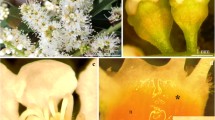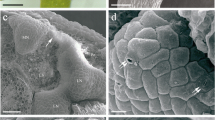Abstract
Nectar composition (sugars and amino acids) of 100 species representing 83 genera from 34 families of angiosperms have been studied. The distribution of the 3 common sugars viz., sucrose, fructose and glucose in nectars of the species studied can be broadly divided into 6 types, based on the presence or absence of any one of the sugars viz sucrose-glucose-fructose, sucrose-glucose, sucrose-fructose, glucose-fructose, glucose and sucrose types with some variations. α-Amino acids were processed in 85 species. Distribution of amino acids was studied in some species and was found to be useful in detecting flower visitors.
Similar content being viewed by others
References
Bahadur B and Ramaswamy N 1984 Pollination biology of heterostylousTurnera subulata J. E. Smith;J. Palynol. 20 198–209
Bahadur B, Rama Swamy N, Chaturvedi A and Farooqui S M 1985 Floral nectaries in two species ofTurnera L. (Turneraceae);New Bot. 12 117–127
Baker H G and Baker I 1973a Amino acids in nectar and their evolutionary significance;Nature (London) 241 543–545
Baker H G and Baker I 1973b Some anthecological aspects of evolution of nectar producing flowers, particularly amino acid production in nectar; inPlant Taxonomy and Ecology (ed.) V H Heywood, (London: Academic Press) pp 243–264
Baker H G and Baker I 1975 Studies of nectar constitution and pollinator plant coevolution; inCoevolution of Animals and Plants; (eds.) L E Gilbert and P H Raven (Austin: University of Texas Press)
Baker H G and Baker I 1976 Analysis of amino acids in flower nectars of hybrids and their parents with phylogenetic implications;New Phytol. 76 87–98
Baker H G, Oplar P A and Baker I 1978 A comparison or the amino acid complements of floral and extra floral nectars;Bot. Gaz. 139 322–332
Baker H G 1978 Chemical aspects of the pollination biology of woody plants in the tropics; inTropical Trees as Living systems; (eds.) P B Tomlinson and M H Zimmerman (Cambridge: Cambridge University Press)
Buchan J L and Savage R I 1952 Paper chromatography of some starch conversion products;Analyst 77 401
Corbet S A 1978 Bees and the nectar ofEchium vulgare; inThe pollination of flowers by insects; (ed.) A J Richards (London: Academic Press) pp. 1–30
Corbet S A, Willmer P G, Beament J W L, Unwin D M and Prys-Jones O E 1979 Post-secretory determinants of sugar concentration in nectar;Plant Cell Environ. 2 293–308
Fahn A 1949 Studies in the ecology of nectar secretions;Pales. J. Bot. Jerusalem 4 207–224
Harborne J B 1982Introduction to Ecological Biochemistry; (London: Academic Press)
Original not referred Hartling L K 1979An investigation of the relationship between bumble bee foraging behaviour and the pollination of red clover: a component analysis approach; M.Sc. thesis, University of Toronto, Canada
Hartling L K and Plowright R L 1979 An investigation of inter- and intra-inflorescence visitation rates by bumble bees on red clover with special reference to seed set;Proc. IVth Int. Symp. on Pollination, Md. Agric. Exp. Sta. Spec. Misc. Publ. 1 457–460
Heinrich B 1979Bumble bee economics; (Massachusetts: Harvard University Press)
Loper G M, Waller G D and Berdel R L 1979 Effect of flower age on sucrose content in nectar ofCitrus;Hortic. Sci. 11 416–417
Luttge U 1961 Uber die Zusammensetzung des Nektars und den Mechanismus Seiner Sekretion I;Planta 56 189–212
Luttge U 1962 Uber die Zusammensetzung des Nektars und den Mechanismus Seiner Sekretion II;Planta 59 108–114
Percival M 1961 Types of nectar in angiosperms;New Phytol. 60 235–281
Ranjan S, Govind Jee and Laloraya M M 1955 Chromatographic analysis on the amino acid metabolism of healthy and diseased leaves ofCroton sparciflorus;Proc. Natl. Inst. Sci. India 21 41–47
Rhoades D F and Bergdahl J C 1981 Adaptive significance of toxic nectar;Am. Nat. 117 798–803
Shuel R W 1975 The production of nectar; inThe hive and the honey bee (Hamilton, Illinois: Dadant and Sons) pp 265–282
Shouthwick E E, Loper G M and Sadwick S E 1981 Nectar production, composition, energetics and pollinator attractiveness in spring flowers of western New York;Am. J. Bot. 68 994–1002
Stephenson A G 1981 Toxic nectar deters nectar thieves ofCatalpa speciosa:Am. Midl. Nat. 105 381–383
Willson M J 1983Plant Reproductive Ecology (New York: John Wiley and Sons)
Wykes G R 1952 An investigation of the sugars present in the nectar of flowers of various species;New Phytol. 51 210–215
Ziegler H 1956 Untersuchungen uber die Leitung and Sekretion der Assimilate;Planta 47 447–500
Author information
Authors and Affiliations
Rights and permissions
About this article
Cite this article
Bahadur, B., Chaturvedi, A. & Rama Swamy, N. Nectar types in Indian plants. Proc. Indian Acad. Sci. 96, 41–48 (1986). https://doi.org/10.1007/BF03053269
Received:
Revised:
Issue Date:
DOI: https://doi.org/10.1007/BF03053269




